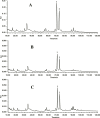Homoisoflavonoids and the Antioxidant Activity of Ophiopogon japonicus Root
- PMID: 28496489
- PMCID: PMC5423261
Homoisoflavonoids and the Antioxidant Activity of Ophiopogon japonicus Root
Abstract
The root of Ophiopogon japonicus has been used as a traditional Chinese medicine and also a functional food ingredient for a long time in China. In the present study, 17 different homoisoflavonoid compounds were identified in the root extract of O. japonicus by HPLC-DAD and LCMS/MS analyses. The antioxidant activity of the of chloroform/methanol (1:1, v/v), methanol and 70% ethanol extracts, and two major isolated homoisoflavonoid compounds (methylophiopogonanone A and methylophiopogonanone B) from O. japonicus root were investigated by various in-vitro assays. Methylophiopogonanone B showed the highest antioxidant ability according to four antioxidant methods. Among the extracts, the chloroform/methanol extract which contained high amounts of homoisoflavonoids was found to exhibit the strongest antioxidant activity. The results showed that O. japonicus root can be regarded as a potential source of homoisoflavonoids and natural antioxidant.
Keywords: Antioxidant activity; Homoisoflavonoids; LCMS/MS analysis; Ophiopogon japonicas.
Figures



Similar articles
-
Characterization of homoisoflavonoids in different cultivation regions of Ophiopogon japonicus and related antioxidant activity.J Pharm Biomed Anal. 2010 Sep 5;52(5):757-62. doi: 10.1016/j.jpba.2010.02.016. Epub 2010 Feb 18. J Pharm Biomed Anal. 2010. PMID: 20226614
-
Homoisoflavonoids profiling of Ophiopogon japonicus by off-line coupling high-speed countercurrent chromatography with high-performance liquid chromatography-diode array detector-quadrupole time-of-flight tandem mass spectrometry.J Sep Sci. 2020 Apr;43(8):1406-1414. doi: 10.1002/jssc.201901222. Epub 2020 Feb 19. J Sep Sci. 2020. PMID: 31999027
-
[Influence of different drying methods on steroidal saponins and homoisoflavonoids in Ophiopogon japonicus].Zhongguo Zhong Yao Za Zhi. 2016 Dec;41(23):4393-4399. doi: 10.4268/cjcmm20162317. Zhongguo Zhong Yao Za Zhi. 2016. PMID: 28933118 Chinese.
-
Ophiopogon japonicus--A phytochemical, ethnomedicinal and pharmacological review.J Ethnopharmacol. 2016 Apr 2;181:193-213. doi: 10.1016/j.jep.2016.01.037. Epub 2016 Jan 27. J Ethnopharmacol. 2016. PMID: 26826325 Review.
-
Ophiopogon japonicus and its active compounds: A review of potential anticancer effects and underlying mechanisms.Phytomedicine. 2023 May;113:154718. doi: 10.1016/j.phymed.2023.154718. Epub 2023 Feb 16. Phytomedicine. 2023. PMID: 36854203 Review.
Cited by
-
Methylophiopogonanone B of Radix Ophiopogonis protects cells from H2O2‑induced apoptosis through the NADPH oxidase pathway in HUVECs.Mol Med Rep. 2019 Oct;20(4):3691-3700. doi: 10.3892/mmr.2019.10625. Epub 2019 Aug 29. Mol Med Rep. 2019. PMID: 31485606 Free PMC article.
-
Proteomic Analysis of the Effects of Shenzhu Tiaopi Granules on Model Rats with Type 2 Diabetes Mellitus.Diabetes Metab Syndr Obes. 2025 Feb 25;18:583-599. doi: 10.2147/DMSO.S493036. eCollection 2025. Diabetes Metab Syndr Obes. 2025. PMID: 40026899 Free PMC article.
-
Therapeutic effects of Jing Si herbal tea for chronic obstructive pulmonary disease: a comprehensive investigation from clinical to basic research.Front Pharmacol. 2025 Jul 21;16:1631839. doi: 10.3389/fphar.2025.1631839. eCollection 2025. Front Pharmacol. 2025. PMID: 40761394 Free PMC article.
-
Simultaneous Extraction and Determination of Characteristic Steroidal Saponins and Homoisoflavonoids in Zhejiang Ophiopogon japonicus.Molecules. 2022 Oct 30;27(21):7380. doi: 10.3390/molecules27217380. Molecules. 2022. PMID: 36364204 Free PMC article.
-
Anti-Inflammatory Properties of Bellevalia saviczii Root Extract and Its Isolated Homoisoflavonoid (Dracol) Are Mediated by Modification on Calcium Signaling.Molecules. 2019 Sep 17;24(18):3376. doi: 10.3390/molecules24183376. Molecules. 2019. PMID: 31533249 Free PMC article.
References
-
- Li N, Zhang L, Zeng KW, Zhou Y, Zhang JY, Che YY, Tu PF. Cytotoxic steroidal saponins from Ophiopogon japonicus. Steroids . 2013;78:1–7. - PubMed
-
- Choi SB, Wha JD, Park SM. The insulin sensitizing effect of homoisoflavone-enriched fraction in Liriope platyphylla Wang et Tang via PI3-kinase pathway. Life Sci. . 2004;75:2653–2664. - PubMed
-
- Wang S, Zhang Z, Lin X, Xu DS, Feng Y, Ding K. A polysaccharide, MDG-1, induces S1P1 and bFGF expression and augments survival and angiogenesis in the ischemic heart. Glycobiology . 2010;20:473–484. - PubMed
-
- Ma C, Li G, Zhang J, Zheng Q, Fan X, Wang Z. An efficient combination of supercritical fluid extraction and high-speed counter-current chromatography to extract and purify homoisoflavonoids from Ophiopogon japonicus (Thunb) Ker-Gawler. J. Sep. Sci. . 2009;32:1949–1956. - PubMed
LinkOut - more resources
Full Text Sources
